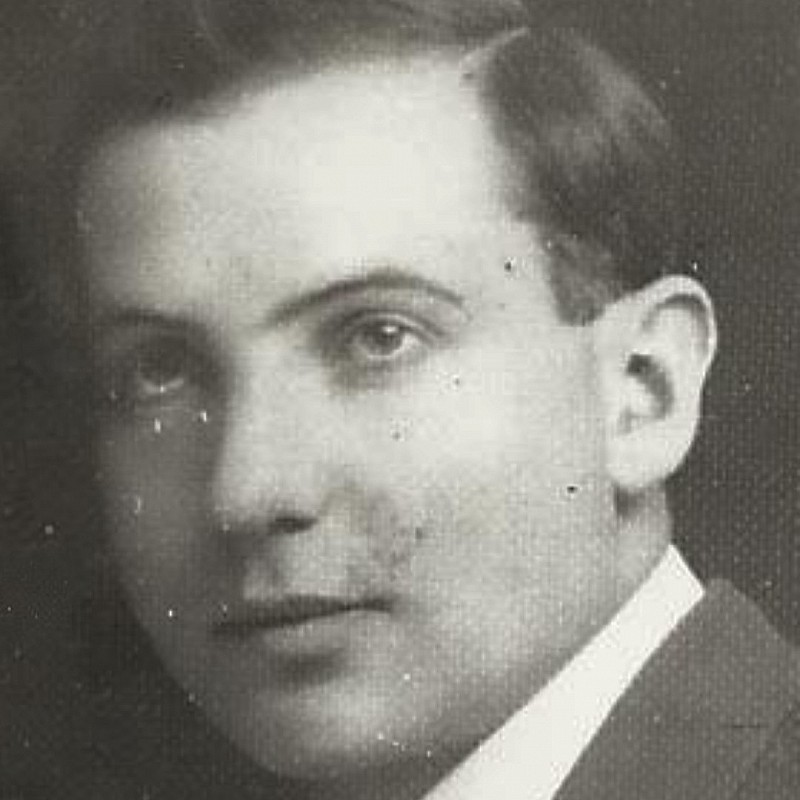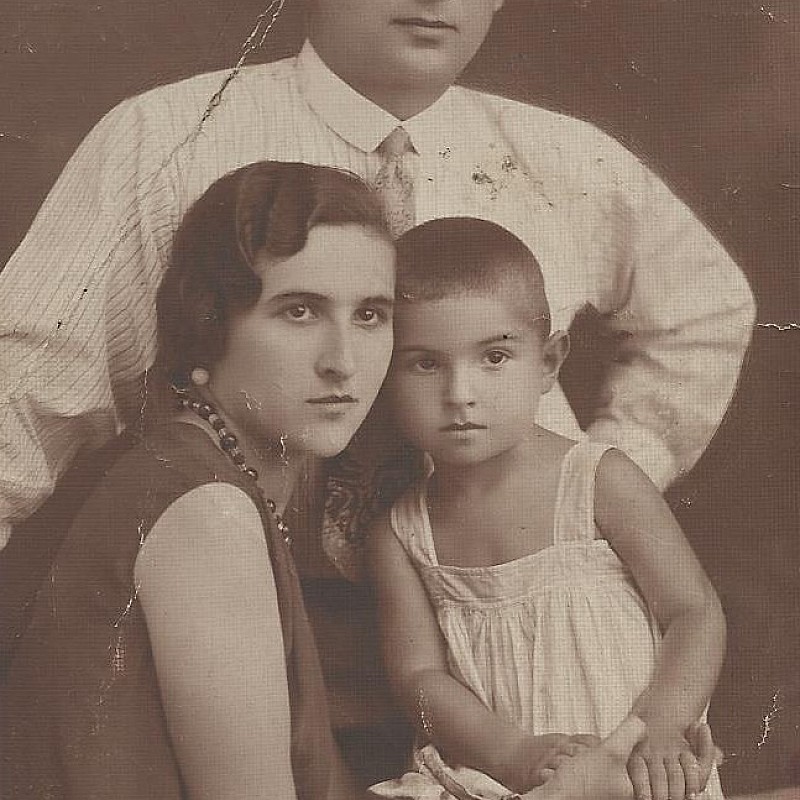Feltöltési adatlap
Részletes adatlap
- Feltöltő neve : Zoltán
- Lakóhelye : Magyarország
- Tárgy típusa : Családi fotó
- Származási idő : 1920 - 1928
Tárgyszavak
- Emlékezet
- Várakozás
- Szabadság
Személyes történet
Háberman Sámuel 1899-ben Nagybereznán született, ma Ukrajna, de akkoriban Kárpátalja a történeti Magyarországhoz tartozott. A vallásos ortodox zsidó család tizenharmadik gyermekeként Sámuel hagyományos nevelést kap a héderben, majd jesiva tanulóként Munkácson él. Orosz fogságba kerül, ahol megismerkedik többek között Rákosi Mátyással és őt is elfogja az akkor még hősies orosz forradalmi hév. 1919-ben hazatér Munkácsra, mely ekkor már Csehszlovákiához tartozott. A 20-as, 30-as években aktívan részt vesz a munkásmozgalomban. Szakszervezeti vezetőként létrehozza a kisiparosok szövetkezetét és ezen belül a szabók érdekeit képviseli. Megalapítja a Proletár Testedző Egyesületet. Indul a Csehszlovák parlamenti választásokon az akkor még legális kommunista párt jelöltjeként.
1926-ban megházasodik Schwartz Gizellával, aki ugyancsak egy szegény kárpátaljai zsidó család sokadik gyermeke. Ekkor egy kis szabóüzemet vezet, ahol varrónők, szabászok méretre ruhákat varrnak. Schwartz Gizi is egy varrónő, akinek megtetszik a becsületes, a béreket és a jó munkahelyi körülményeket biztosító emberséges vezető. Samu is szemet vet a fiatal és mindenki által gyönyörűnek tartott fekete lányra.
Megházasodnak, 1926. május 9-én megszületik gyermekük, Miklós, aki a Moshe Arie héber nevet kapja a brit mila (körülmetélés) szertartás során. A gyereket a cionista Munkácsi Héber Gimnáziumba íratják, ami szintén belefért a kor sokszínű világába.
Sámuelnek 1938-ban titokban el kell hagynia Munkácsot. 1939-ben a kommunista illegális mozgalom segítségével a Szovjetunióba szökik, ahol a donyecki bányavidéken dolgozik. 1941 tavaszán felesége és fia is utána mennek. Egy egyezmény keretében a magyar hatóságok kiadják Schwartz Gizellát és Háberman Miklóst és más emigrációban élő kommunisták családtagját a Szovjetuniónak, még az 1848-49-es magyar forradalomban az oroszok által zsákmányolt zászlókért cserébe. A család csak igen rövid ideig marad együtt, ugyanis még ebben az évben a német fasiszta hadsereg megtámadja a Szovjetuniót, így Hábermann Sámuel önként jelentkezik a frontra.
Ejtőernyős kiképzés után Vorosilovgradban (Luganszk) egy krasznodari (Fekete-tenger melletti) gelendzsiki reptérről egy hattagú ejtőernyős csoport parancsnok-helyetteseként kerül bevetésre, hogy a Kárpátokban megszervezzék a fasiszta-náci német és kiszolgálóik – köztük Magyarország – elleni partizán mozgalmat. Az éjszaka leple alatt 1942. január 4-én ledobták őket, Hábermann Sámuel és még két bajtársa tűzharcban meghaltak. Más források szerint elfogták őt, majd megállapították, hogy Spiegel Lajos névre szóló iratai hamisak. Kőrösmezői kihallgatása során valószínűleg megkínozták és brutálisan megölték. A csoport többi tagját, köztük Borkanyuk Eleket (Oleksza, Alex) 1 is elfogták és Budapesten kivégezték. Az ellenállók egységét, akik orosz katona-egyenruhában ugrottak le, felfedezték a határvadászok, vezetőjüket, a kárpátaljai Borkanyuk Eleket a VKF (Vezérkari Főnökség) különbíróságának ítélete alapján kivégezték.
Felesége, Gizella és Miklós, amint halálhíréről értesültek, önként jelentkeztek a szovjet hadseregbe frontszolgálatra, egészen a háború végéig. Mindketten a frontvonalban harcoltak. A szovjet hadsereg kihasználta magyar nyelvismeretüket, emellett még kitűnően beszéltek jiddisül és oroszul is. 1940-től először a szovjet hátországban dolgoznak, Miklós a kazahsztáni Alma-Atában vasesztergályos egy gyárban, ahol jegyre veszik a sovány élelmiszeradagokat. Budapesten a Szövetséges Ellenőrző Bizottságban tevékenykedtek egészen 1947-es leszerelésükig, majd hazatértek Kárpátaljára. Háberman Miklós és anyja, Gizella, Kárpátalján maradnak még több mint húsz éven keresztül, egészen 1971-ig, amikor Budapestre települnek át Miklós két fiával és feleségével együtt.
-
Sámuel Háberman was born in 1899, in Nagyberezna (Velykyi Bereznyi), which is now in Ukraine, but in those days it belonged to historical Hungary. As the thirteenth child of an orthodox Jewish family, he received a traditional education first in a cheder or cheider (a traditional elementary school teaching the basics of Judaism and the Hebrew language), and then in a yeshiva (a Jewish educational institution of advanced studies that focuses on the study of traditional religious texts, primarily the Talmud and the Torah), the latter in Munkács (Mukachevo). Munkács had the most significant Jewish community in Transcarpathia (Zakarpattia Oblast in Ukrainian, Kárpátalja in Hungarian), with almost half of the population of the town being Jewish. Many, including Sámuel Háberman himself, start to realize that the traditional way of life is in crisis; it does not give answers to their questions. Why is there so much suffering, misery and famine on earth? What may be God's purpose with striking the devoutly religious communities with anti-Semitism, persecution and pogroms? He trains to become a tailor in Ungvár (now Uzhhorod), but in 1916 he is summoned into the Austro-Hungarian Army and is sent to the eastern front. He is taken prisoner by the Russians, where he becomes acquainted with Mátyás Rákosi and others, and is overcome by the then still heroic Russian revolutionary heat. This is perhaps the moment when all that the Jews have been proclaiming for thousands of years may become reality for the boy who has been brought up in a Messianic faith. A happier and more equitable age is to arrive. Humankind, led by Leninist Soviet Union, will take sides with the dispossessed and the distressed and fight for a better future for everyone. In 1919 he arrives back home to Munkács, which, at that time, already belonged to Czechoslovakia. During the 1920s and 30s he plays an active role in the labour movement. As a trade-union leader, he creates the cooperative of artisans within which he represents the interests of tailors for better wages and living conditions, which nowadays come as natural but in those days were considered as radically and progressively new. He establishes the Proletarian Gymnastics Association. Under his leadership, summer camps and sporting events are organised for the working youth at a time when sports and leisure time are the sole privilege of the rich. He is also elected as a representative of the municipality. He runs for the Czechoslovakian parliamentary elections as a candidate of the then still legal Communist Party. In 1926, he marries Gizella Schwartz, herself one of many children of a poor Transcarpathian Jewish family. He manages a small tailoring workshop where seamstresses and tailors sew clothes to measure. Gizi Schwartz, one of the seamstresses, is attracted to the honest and humane manager who provides them wages and good working conditions. Sámuel himself sets eyes on the young, dark girl, whose beauty is admired by all around her. They get married, and on 9th May, 1926 their son, Miklós is born. Miklós receives his Jewish name, Moshe Arie, at his brit milah (circumcision) ceremony, which, even for a Communist, was natural as a folkloristic, cultural event. The child is later enrolled at the Zionist Hebrew Secondary Grammar School of Munkács, which also fit the culturally diverse world of the era. For a speech he made on 1st May, 1934, and in which he mentioned the Soviet Union in a positive context, Sámuel was sentenced to a one-year imprisonment. His wife also becomes a Communist, and there are times when they are both imprisoned. They are constantly harassed by the police authorities, their house is repeatedly being searched. He has intimate knowledge of the life of common people, and he speaks their language. He organizes training camps, and he enchants the masses with his speeches. “Work and bread” was not only a slogan for him, he was strongly convinced that people must fight for basic human rights. In 1937, still enjoying relative freedom, they go to Paris, like many thinkers and artists of the time, where, at the world fair, Picasso's Guernica is exhibited in the pavilion of the Spanish Republic. This idyllic life proved to be ephemeral in the life of this assimilating family demanding an equality of rights.
Following the First Vienna Award in November 1938, a significant part of Transcarpathia, including Munkács, was annexed to Hungary. The Horthyist Hungarian laws were more cruel than ever before. Activists suspected to be Communists are outlawed and persecuted as criminals. He is sentenced to death in absentia, and because of this he has to leave Munkács stealthily in 1938. Anti-Jewish Laws are already operative in 1939, and the territory becomes controlled by the Hungarian Ministry of the Interior. Misery and persecution becomes more and more terrible from now on, ending in the murdering of the majority of Jews. Sámuel Háberman does not wait to be deported. Helped by the illegal Communist movement, he flees to the Soviet Union, and starts working in the coal mining region of Donetsk. In the spring of 1941, he is followed there by his wife and son. Within the framework of an agreement, Gizella Schwartz and Miklós Háberman together with several other family members of Communist exiles are extradited to the Soviet Union in exchange for flags captured by Russian troops during the 1848-49 Hungarian Revolution. The family is reunited only for a very short period of time, since the Nazi German Army attacks the Soviet Union that same year, and Sámuel Háberman volunteers for front service. Following a parachute training in Voroshilovgrad (now Luhansk), he is deployed as second-in-command of a parachute unit of six from an airport in Gelendzhik (on the Black Sea) to organize a partisan resistance movement in the Carpathian Mountains against the Nazi German forces and their aids, including Hungary. At night, on 4th January, 1942, they were dropped down, and Sámuel Háberman and two of his comrades were killed in a gunfight. According to other sources, he was captured and his documents issued for Lajos Spiegel were found to be faked. During his interrogation in Kőrösmező (now Yasinia), he was probably tortured and brutally murdered. The other members of the group, Elek Borkanyuk (Olexa, Alex) among them, were also captured and then executed in Budapest. The unit of resistance fighters, who were dropped down in Russian military uniforms, were found by members of the border patrol and their leader, Elek Borkanyuk from Transcarpathia, was executed based on the verdict of the special court of the Chiefs of Staff. Sámuel Háberman's older brother, Sándor, lost his life as a soldier of the Czech Legion in a battle fought for the liberation of Prague. Other members of his family were murdered in Auschwitz and other death camps. Some of those who survived went to Palestine and fought for the Jewish state or later in the wars of Israel. Upon learning of his death, his wife, Gizella, and his son, Miklós, volunteered for front service in the Soviet army, right up until the end of the war. They both fought in the front lines. The Soviet army made use of their knowledge of the Hungarian language and the fact that they spoke fluent Yiddish and Russian as well. From 1940, they first start working in the Soviet hinterland with Miklós being an iron turner in a factory in Almaty, where they buy their meagre food rations for coupons. In Budapest, they are active in the Allied Control Commission until their discharge in 1947, and then they return to Transcarpathia. Miklós Háberman and his mother, Gizella, remain in Transcarpathia for about another twenty years. In 1971 they immigrate to Budapest, Hungary together with the two sons and wife of Miklós.


